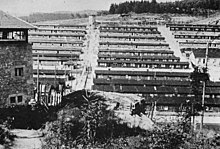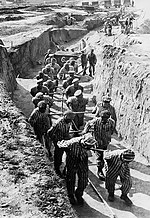
Fresnes Prison is the second largest prison in France, located in the town of Fresnes, Val-de-Marne, south of Paris. It comprises a large men's prison of about 1200 cells, a smaller one for women and a penitentiary hospital.

Aufseherin was the position title for a female guard in Nazi concentration camps. Of the 50,000 guards who served in the concentration camps, training records indicate that approximately 3,500 were women. In 1942, the first female guards arrived at Auschwitz and Majdanek from Ravensbrück. The year after, the Nazis began conscripting women because of a shortage of male guards. In the context of these camps, the German position title of Aufseherin translates to (female) "overseer" or "attendant". Later female guards were dispersed to Bolzano (1944–1945), Kaiserwald-Riga (1943–44), Mauthausen, Stutthof (1942–1945), Vaivara (1943–1944), Vught (1943–1944), and at Nazi concentration camps, subcamps, work camps, detention camps and other posts.
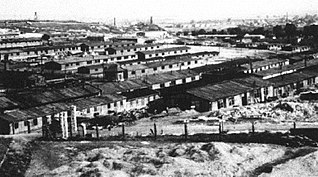
The German camps in occupied Poland during World War II were built by the Nazis between 1939 and 1945 throughout the territory of the Polish Republic, both in the areas annexed in 1939, and in the General Government formed by Nazi Germany in the central part of the country (see map). After the 1941 German attack on the Soviet Union, a much greater system of camps was established, including the world's only industrial extermination camps constructed specifically to carry out the "Final Solution to the Jewish Question".

Mittelbau-Dora was a Nazi concentration camp located near Nordhausen in Thuringia, Germany. It was established in late summer 1943 as a subcamp of Buchenwald concentration camp, supplying slave labour from many Eastern countries occupied by Germany, for extending the nearby tunnels in the Kohnstein and for manufacturing the V-2 rocket and the V-1 flying bomb. In the summer of 1944, Mittelbau became an independent concentration camp with numerous subcamps of its own. In 1945, most of the surviving inmates were sent on death marches or crammed in trains of box-cars by the SS. On 11 April 1945, US troops freed the remaining prisoners.
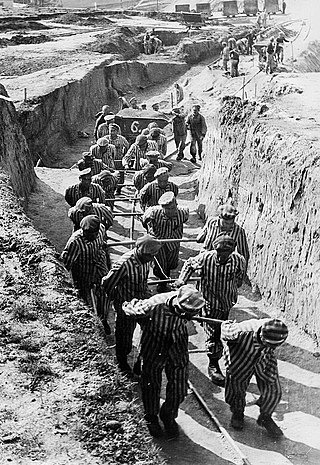
From 1933 to 1945, Nazi Germany operated more than a thousand concentration camps, including subcamps on its own territory and in parts of German-occupied Europe.

German Earth and Stone Works was an SS-owned company created to procure and manufacture building materials for state construction projects in Nazi Germany. DEST was a subsidiary company of Amtsgruppe W of SS Main Economic and Administrative Office (WVHA). Both Amt. W and the WVHA were headed by Waffen-SS generals Oswald Pohl and Georg Lörner.

The Dachau trials, also known as the Dachau Military Tribunal, handled the prosecution of almost every war criminal captured in the U.S. military zones in Allied-occupied Germany and in Allied-occupied Austria, and the prosecutions of military personnel and civilian persons who committed war crimes against the American military and American citizens. The war-crime trials were held within the compound of the former Dachau concentration camp by military tribunals authorized by the Judge Advocate General of the U.S. Third Army.

Arnold Strippel was a German SS commander during the Nazi era and a convicted criminal. As a member of the SS-Totenkopfverbände, while assigned to the Neuengamme concentration camp, he was given the task of murdering a group of children who had suffered a tuberculosis medical experiment conducted by Kurt Heissmeyer.
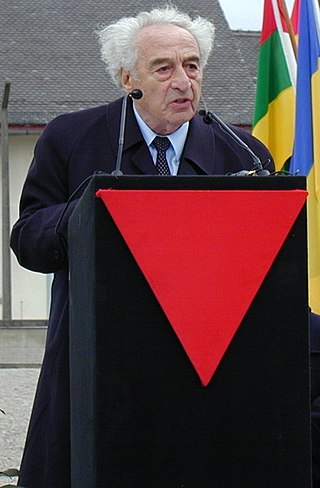
International concentration camp committees are organizations composed of former inmates of the various Nazi concentration camps, formed at various times, primarily after the Second World War. Although most survivors have since died and those who are still alive are generally octogenarians, the committees are still active.

The Final Journey is a 2010 documentary that chronicles the largest of the Nazi concentration camps that were scattered throughout Germany during the Third Reich. Created and directed by the film maker R. J. Adams and narrated by Paul Kirby, the program focuses entirely on who played key roles and how in their contribution to the tragedy of the Holocaust.

Wolfgang Benz is a German historian and anti-semitism researcher from Ellwangen. He was the director of the Center for Research on Antisemitism of the Technische Universität Berlin between 1990 and 2011, and is also a member of the advisory board for the Memorial to the Murdered Jews of Europe and was involved in the memorial's design. He has written or published over 200 works. He is considered to be one of the most renowned and well-known historians in modern Germany, and one of the foremost scholars on anti-semitism studies. He has been referred to as the "doyen" of anti-semitism research.

During the Holocaust, death marches were massive forced transfers of prisoners from one Nazi camp to other locations, which involved walking long distances resulting in numerous deaths of weakened people. Most death marches took place toward the end of World War II, mostly after the summer/autumn of 1944. Hundreds of thousands of prisoners, mostly Jews, from Nazi camps near the Eastern Front were moved to camps inside Germany away from the Allied forces. Their purpose was to continue the use of prisoners' slave labour, to remove evidence of crimes against humanity, and to keep the prisoners to bargain with the Allies.

Ernst Heinrich Schmidt was a German physician and member of the SS, who practised Nazi medicine in a variety of German concentration camps during World War II. He was tried in 1947 and 1975 for complicity in war crimes, but was acquitted both times.

Subcamps, officially Arbeitslager der Waffen-SS, were outlying detention centres (Haftstätten) that came under the command of a main concentration camp run by the SS in Nazi Germany and German-occupied Europe. The Nazis distinguished between the main camps and the subcamps subordinated to them. Survival conditions in the subcamps were, in many cases, poorer for the prisoners than those in the main camps.
Hermine Boettcher-Brueckner was a Nazi SS auxiliary guard at several concentration camps between 1942 and 1945. In 1948 she was convicted for war crimes for her role in the Holocaust, and sentenced to imprisonment; she was tried again in 1975 but acquitted on lack of evidence. Her fate after the trial remains unknown.
Albert Sauer was a Nazi German commandant of Mauthausen-Gusen concentration camp. He died of wounds in 1945, and was never tried for his role in The Holocaust.

During World War II, the German Luftwaffe staffed dozens of concentration camps, and posted its soldiers as guards at many others. Camps created for the exploitation of forced labor for armaments production were often run by the branch of the Wehrmacht that used the products. The Wehrmacht also posted about 10,000 soldiers to concentration camps because of a shortage of guards in mid-1944, including many from the Luftwaffe.

Der Ort des Terrors. Geschichte der nationalsozialistischen Konzentrationslager is a nine-volume German encyclopedia series of Nazi Germany's camp system, published between 2005 and 2009 by Wolfgang Benz and Barbara Distel for C. H. Beck. It was edited by Angelika Königseder of the Zentrum für Antisemitismusforschung. The first volume deals with central issues concerning the Nazi camp system, volumes 2 to 7 contain articles on the main concentration camps and their subcamps in chronological order. Volume 8 deals with concentration and extermination camps in German-occupied Eastern Europe. Volume 9 also lists other types of camps in the Nazi forced labor camp system.

Kauen was a Nazi concentration camp located in the former Kovno Ghetto. It operated from 15 September 1943 to 14 July 1944 and had seventeen satellite camps located around the city of Kaunas, in modern-day Lithuania. Most prisoners were Jews who had survived the previous years of the Holocaust in Lithuania. In July 1944, eight of the subcamps were closed. The main camp was liberated by the Red Army on 1 August 1944.


